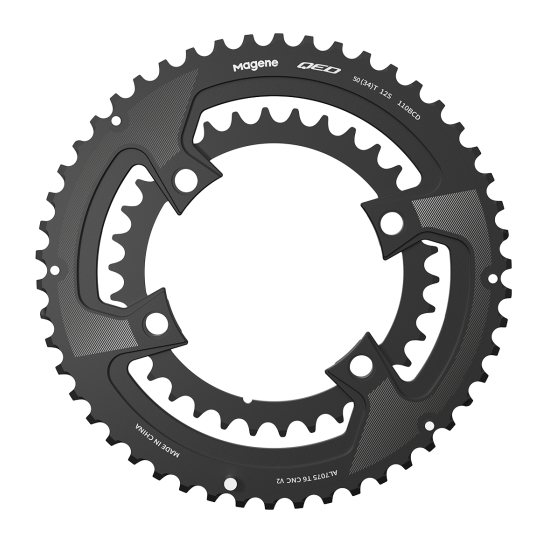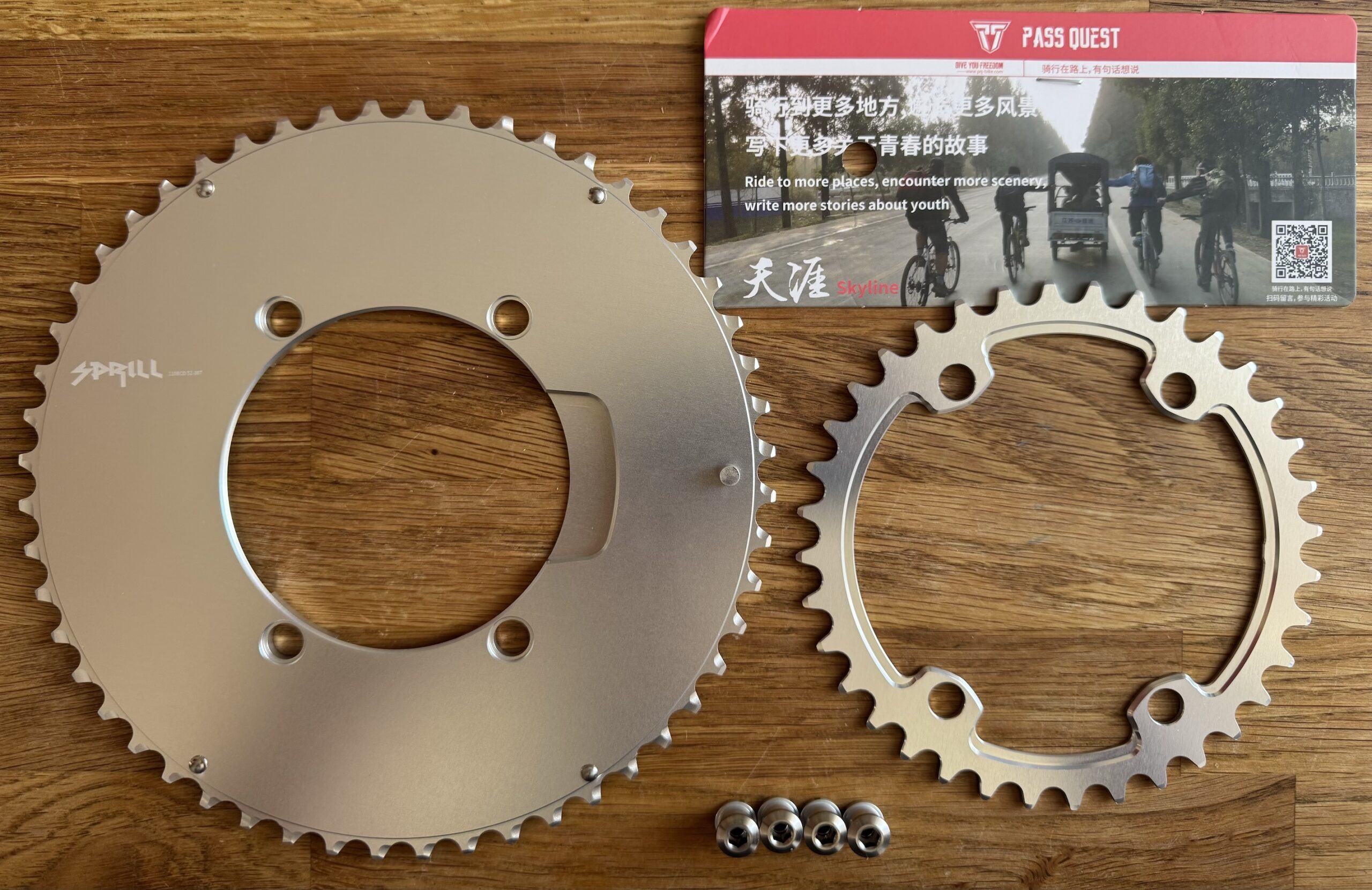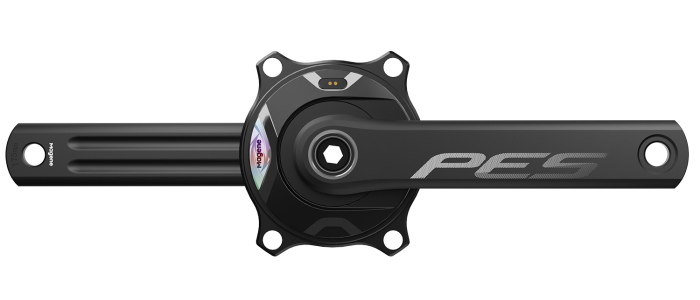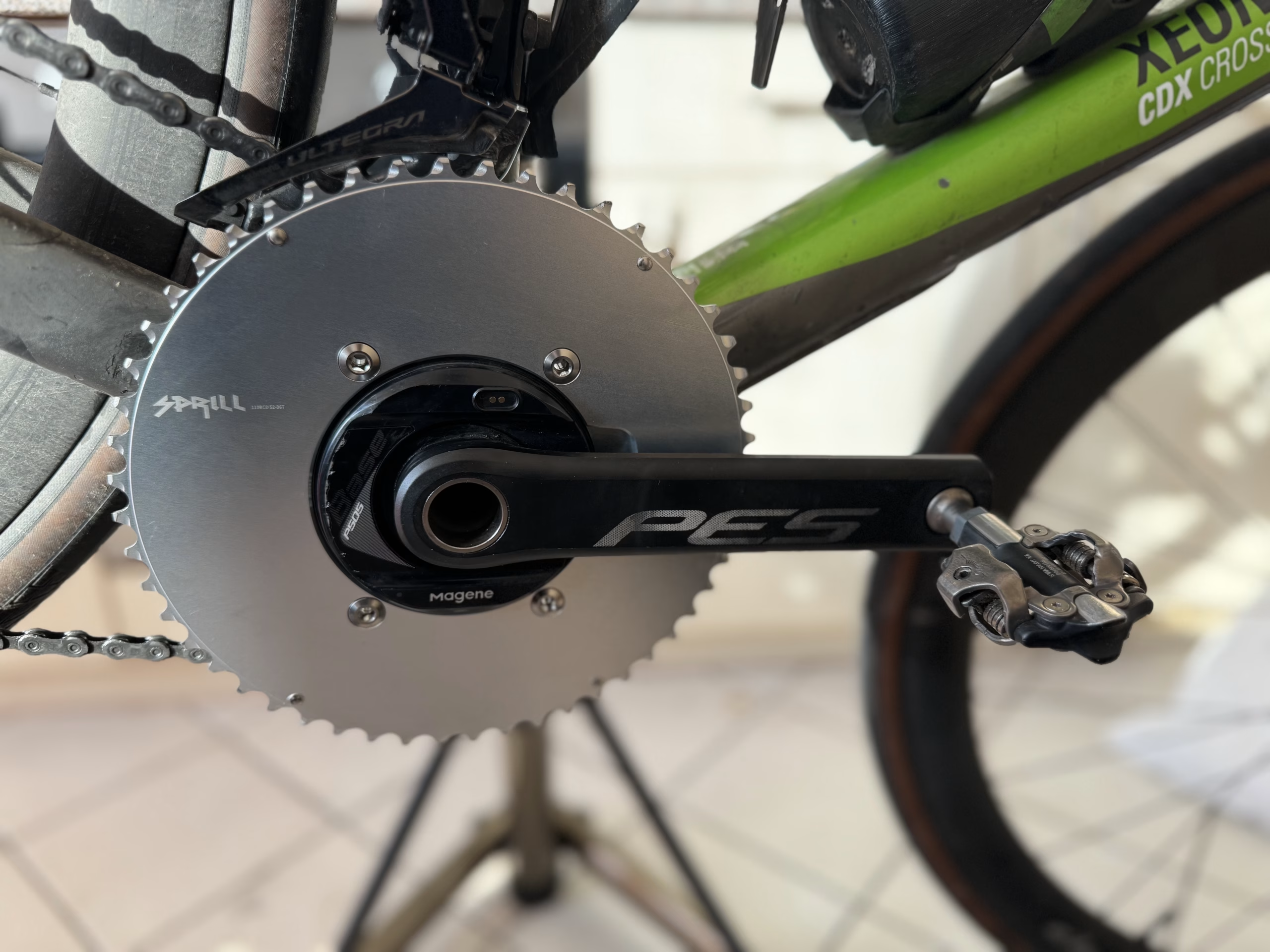📅 Update (August 2025): The Magene P515 is now the current model and available for purchase. This review is based on extensive P505 experience, but all findings apply to the P515 with the added benefits of improved accuracy, longer battery life, and T47 compatibility.

Are you running a 11 or 12 speed Shimano Road Groupset and looking to upgrade to a Power Meter on a budget? The Magene PES P515 Power Meter Crankset may just be the right option for you.
In this comprehensive review, I’ll share my experience using the P505 for over a year, including setup, performance testing with different chainrings, and long-term reliability. Plus, I’ll explain how these insights apply to the current P515 model to help you make an informed decision.
🚀 TL;DR – Quick Summary:
✅ Best Budget Power Meter: P515 offers excellent value at $299
✅ Real-world tested: 1+ years of reliable performance
✅ Key improvements: 330h battery, ±1.0% accuracy, T47 support
⚠️ Main limitation: Heavy at 625g vs premium options
🎯 Perfect for: Budget-conscious cyclists prioritizing accuracy over weight
Specifications
The Magene PES P515 Power Meter Crankset is designed to be a drop-in replacement for Shimano Hollowtech II Bottom Brackets (including T47) and 110 BCD 4 bolt chainrings. If you are running a Shimano GRX Groupset, you will need new 110 BCD 4 bolt chainrings.
| Weight | 625g (crankset + power meter) |
| Power Meter Weight | ~100g (spider only) |
| Compatibility | Shimano Hollowtech II, 110 BCD 4-bolt, T47 |
| Power Accuracy | ±1.0% |
| Battery Life | Up to 330+ hours |
| Connectivity | ANT+ and Bluetooth |
| Measurement Type | Spider-based (total power) |
| Bottom Bracket | Hollowtech II (including T47) |
| Price Range | ~$299 |
When purchasing the Magene PES P515 Base Power Meter Crankset you can choose between a version with or without chainrings. I’d recommend keeping your existing chainrings if possible.
Budget Power Meter Comparison
How does the P515 stack up against other budget power meter options? Here’s a comprehensive comparison:
| Feature | Magene P515 | 4iiii Precision | Stages Gen 3 | Favero Assioma |
|---|---|---|---|---|
| Price | $299 | $399+ | $449+ | $749+ |
| Measurement | Spider (Total Power) | Left Crank (Doubled) | Left Crank (Doubled) | Dual Pedals |
| Weight | 625g | +7g (vs standard crank) | +20g (vs standard crank) | 319g (pedals) |
| Accuracy | ±1.0% | ±1.0% | ±1.5% | ±1.0% |
| Battery Life | 330+ hours | 100+ hours | 175+ hours | 50+ hours |
| L/R Balance | Estimated | No | No | True L/R |
| Installation | Replace crankset | Replace left crank | Replace left crank | Replace pedals |
| Compatibility | Shimano Hollowtech II BB | Wide compatibility | Wide compatibility | Universal |
Why Choose the P515?
Best value for spider-based measurement: The P515 offers true total power measurement (not doubled estimates) at the lowest price point. While heavier than crank-based options, it provides more accurate total power readings.
Exceptional battery life: At 330+ hours, the P515 outlasts most competitors by 2-3x, reducing maintenance hassle.
Future-proof compatibility: T47 support and Shimano integration make it ideal for modern bike builds.
Quick Buying Guide: Who Should Get the P515?
✅ Perfect for:
- Budget-conscious cyclists wanting their first power meter
- Training enthusiasts who prioritize accuracy over weight
- Riders with Shimano groupsets seeking easy compatibility
- Cyclists with T47 bottom brackets (now supported in P515)
❌ Look elsewhere if:
- Weight weenies focused on minimal bike weight
- Frequent upgraders who change components regularly
- Professional racers needing dual-leg power measurement
- Non-Shimano users without 110 BCD compatibility
Installation Guide and Setup
In this section we will take a look at what is in the box, the power meter installation and setup.
Unboxing and Package Contents
After your Magene PES P515 Base Power Meter Crankset has arrived in the mail, it’s time to check everything is included:
- Pair of PES Crankarms
- P515 Base Power Meter
- Power Meter Lockring
- Power Meter Lockring Adapter
- PES Crankarm Endcap Bolt
- PES Crankarm Replacement Rubber O-Rings
- 4x Chainring Bolts
- Magnetic Charging Cable
- Stickers
- User Manual
Step-by-Step Installation Process
To assemble the Magene PES P515 Power Meter crankset you will need the following additional tools:
1. Installing the Power Meter Spider
As the first step you will have to install the Base Power Meter on the Crankset. You will need the TL-FC32 Hollowtech Tool and the included Lockring Adapter for the Magene Power Meter.
🔧 Installation Tip: Ensure the power meter spider is fully seated before tightening. The lockring should thread smoothly – if you encounter resistance, check alignment.
2. Chainring Installation
After you have installed the Power Meter, it’s time to install the Chainrings. If you are re-using your Shimano Chainrings including the Original Chainring Screws the Maximum Installation Torque is 12 Nm, when using the Magene Chainring Screws, 8 Nm should not be surpassed.
3. Crankset Assembly
After the Chainrings have been installed it’s time to install the Crankset. Put the Crankset through the Bottom Bracket and slide the Crankarm onto the crankshaft. Install the Crankarm Endcap Bolt and use it to adjust the bearing preload, which is around 1-1.5 Nm. Now it is time to tighten down the crankarm bolt with 12-14 Nm. After you are done with that, you can torque down the endcap bolt to 10-12 Nm.
Make sure to check the torques after around 100 km of riding.
⚠️ Critical Re-check: Plan to re-torque all bolts after your first 100km. The initial settling process may require adjustment to maintain proper preload.
Initial Setup and Pairing
- Download the Magene App – Essential for initial configuration and firmware updates
- Charge the power meter – Use the magnetic charging cable before first use
- Pair with your head unit – Both ANT+ and Bluetooth supported
- Perform initial calibration – Wait 10-15 minutes into your first ride for thermal stability
Real-World Testing: Chainring Performance
My previous crankset came with 34-50T Chainrings and I wanted to make the move to a 36-52T so I tested different options:
Magene QED Chainrings

The magene QED chainrings are extremely lightweight at a quoted 143g for the 34-50T setup. They are also available in 36-52T and 39-53T configurations.
The shifting felt mostly similar to Shimano, with the chain only rarely dropping and the weight is excellent. Unfortunately I had issues with the Magene Chainring bolts getting loose and I replaced them with Titanium counterparts, which can also be torqued higher at 10 Nm instead of just 8 Nm for the magene aluminium bolts. This still did not fix the lacking stiffness, which may be relevant for you if you like pushing higher wattage numbers. That was one of the reasons why I stopped using the QED chainrings and switched to a more stiffer option.
⚠️ QED Chainring Issues: While lightweight, the QED chainrings showed noticeable flex under high power (>300W sustained). Bolts required frequent retightening despite using titanium replacements torqued to 10 Nm.
Passquest Aero Chainrings

The passquest aero chainrings look cool in the first place, but they are also stiff as hell. No wobble or such like with the Magene QED chainrings. There is also an option to get an upgrade to titanium chainring bolts from the seller.
Unfortunately the shifting performance is not the greatest and they are quite heavy at almost 220g for the bundle. Therefore nothing for the weightweenie, but they have lasted over a year so far. So if you want some aero chainrings that are solid with mediocre shifting, these are the go to.
I also had the issue that the chainline would be too far outward for my 12 speed di2 fd-r8150 front derailleur, so I had to install some spacers under the front derailleur mount to move the chainline further outwards. If this is not possible on the frame, you may have to switch to a GRX derailleur for example which has a 2.5mm further outward chainline.
💡 Passquest Pro Tip: The aggressive chainline positioning may require front derailleur adjustments. Check compatibility with your specific setup before ordering.
Chainring Testing Results Summary
| Chainring | Weight | Stiffness | Shifting Quality | Price | Recommendation |
|---|---|---|---|---|---|
| Shimano Ultegra FC-R8100 | 157g | Excellent | Perfect | $$$ | ✅ Best overall |
| Magene QED | 143g | Poor | Good | $ | ⚠️ Weight weenies |
| Passquest Aero | 217g | Excellent | Mediocre | $$ | 🎯 Style + stiffness |
Conclusion: Nothing can match the Shimano Chainrings shifting performance really. So if you can keep them, their weight in the Ultegra and Dura Ace Categories is pretty much excellent and their stiffness too. If you want to collect style points and don’t care about stiffness with good shifting go for the Magene QED chainrings, the passquest aero chainrings are also fine, if you want stiffness and style points, but their shifting quality could be better and they are quite heavy after all.
Power Meter Performance and Features
Functionality
The power meter works perfectly out of the box. You have to initially configure it via the Magene App and you can also update the firmware there.
After that you can pair it with your GPS Head Unit, from which you can also start the calibration. I typically calibrate the power meter 10-15 min into the ride to get accurate readings.
I had no connectivity dropouts and the power meter also reports the cadence so no separate cadence sensor needed.
The left and right balance is estimated from the pedal position, but what matters the most are accurate total power readings which work fine due to the nature of the power meter being between the crankset and chainring (spider power meter)
✅ Setup Success: Zero connectivity issues after initial pairing. The built-in cadence measurement eliminates the need for additional sensors, simplifying your setup.
Physical Properties
I had some issues initially with the crankarm getting loose and almost falling off, after retorquing it multiple times this issue solved itself however. I guess the single bolt design could be improved here to a dual bolt design like Shimano. Another downside is the proprietary crankarm spider interface, which limits you to using the P505 power meter with magenes crankset. You won’t be able to use any aftermarket cranks. In case you want to have another crankarm length you will have to contact magenes support to send another pair and your old ones will go to waste.
Also the weight is quite heavy at 625g, which is about 100g heavier than a 105 Crankset.
⚠️ Initial Setup Issues: The single-bolt crankarm design required multiple retorquings during the first few rides. Once properly seated, this issue disappeared, but consider checking torque after initial rides.
Long-Term Performance: After a Year of Use
Battery Life and Connectivity
After over a year of using the crankset, the functionality was flawless. No connection dropouts and the battery lasts forever. I have to recharge my Di2 Battery about every 1-1.5 Months, the power meter battery typically lasts 3-4x Di2 Charge cycles, I can’t even remember when I last charged it. So you can easily go like 4000-5000km with the powermeter on a single charge which is amazing.
🔋 Outstanding Battery Performance: With the P515’s 330h rating (vs P505’s 200h), you can expect even better battery life. Real-world testing shows 4000-5000km range per charge cycle for the older P505 variant.
Durability and Build Quality
After the initial issues with the crankset getting loose the issue disappeared. The power meter spider and electronics have shown no signs of wear or degradation. Weather resistance has been excellent through various conditions including rain, mud, and temperature extremes.
The magnetic charging port remains clean and functional, though I recommend keeping the protective cap in place when not charging to prevent debris accumulation.
P515 Update: Key Improvements Over the P505
The Magene P515 addresses some limitations I experienced with the P505 during my year-long test. Here’s how the improvements impact the overall value proposition:
| Improvement | P505 | P515 | Impact |
|---|---|---|---|
| Power Accuracy | ±1.5% | ±1.0% | Better training data precision |
| Spider Weight | 110g | 100g (-10g) | Slightly reduced rotating mass |
| Battery Life | 200 hours | 330 hours (+65%) | Less frequent charging needed |
| Bottom Bracket | No T47 support | T47 compatibility added | Works with more bike frames |
| Total Weight | 650g | 625g | Slightly more lightweight |
Should You Buy the updated P515?
✅ The P515 is now the clear choice since it’s the only model available and addresses some P505 limitations without increasing the price.
Key improvements that matter:
- 65% longer battery life – Reduces charging frequency significantly
- Better accuracy (±1.0%) – More precise training data
- T47 compatibility – Works with more modern bike frames
- Slightly more lightweight – Less additional weight over non-powermeter cranksets
Limitations that remain: Unfortunately, Magene didn’t address the main concerns from my P505 experience – the overall weight is still somewhat heavy at 625g, and the chainring stiffness issues appear unchanged. The proprietary crankarm interface also remains.
Frequently Asked Questions (FAQ)
Is the Magene P515 worth it in 2025?
Yes, the P515 offers excellent value at $299 with ±1.0% accuracy, 330+ hour battery life, and spider-based total power measurement. It’s one of the most affordable ways to get accurate power data, especially for Shimano groupset users.
What’s the difference between P505 and P515?
The P515 improves on the P505 with better accuracy (±1.0% vs ±1.5%), longer battery life (330h vs 200h), T47 bottom bracket support, and lighter spider weight (100g vs 110g). The price remains the same at $299.
Does the P515 work with non-Shimano groupsets?
The P515 requires 110 BCD 4-bolt chainrings and Hollowtech II bottom bracket compatibility. It works with SRAM and other brands that use these standards, but you may need new chainrings for GRX or other compact groupsets.
Can I use my existing chainrings with the P515
Yes, if you have 110 BCD 4-bolt chainrings. Shimano chainrings work best for optimal shifting performance. My testing showed aftermarket options can compromise shifting quality and may have stiffness issues under high power.
How long does the P515 battery last?
Magene claims 330+ hours, which translates to over 5000km of riding. In my P505 experience (200h rated), I typically charged 3-4x less frequently than my Di2 battery, making it very low maintenance.
Is the P515 too heavy for racing?
At 625g total weight, the P515 is more than 100g heavier than premium Shimano cranksets. For weight-conscious racers, this may be significant. However, for training and recreational riding, the accuracy and value outweigh the weight penalty.
What bottom brackets work with the P515?
The P515 supports all Hollowtech II bottom brackets, including standard threaded BB (BSA), PF30, BB86, and now T47. This makes it compatible with most odern road and gravel bikes.
Final Verdict: Is the Magene P515 Worth It?

The Magene P515 is an excellent budget power meter that builds on the solid P505 foundation with meaningful improvements. If you don’t care about weight and you don’t intend to change out the provided crankset, this is one of the best value propositions in the power meter market.
| What is good | + Excellent battery life (330+ hours in P515) + Budget-friendly price (~$299) + Accurate power readings (±1.0% in P515) + Easy installation + No connectivity issues + Includes cadence measurement + 110 BCD compatibility + T47 bottom bracket support (P515) + Proven long-term reliability |
| Shortcomings | – Heavy (625g vs ~525g typical Shimano crankset) – Proprietary crankarm interface – Initial crank loosening issues – Limited chainring upgrade options – Single bolt design could be improved – Requires specific tooling for installation |
The P515 improvements – especially the 65% longer battery life and better accuracy – make this an even stronger recommendation than the P505 was.
It’s best to use the original chainrings to retain the original shifting performance, as my testing with aftermarket options showed various compromises.
If you are more weight conscious and don’t mind paying extra I would recommend checking out my article for building your own spider power meter crankset on a budget.
🎯 Bottom Line: The Magene P515 delivers exceptional value for budget-conscious cyclists. While not the lightest option, it offers proven accuracy, outstanding battery life, and reliable performance that justifies its position as a top budget power meter choice in 2025.


Leave a Reply